Pump Handbook by Igor J. Karassik, Joseph P. Messina, Paul Cooper, Charles C. Heald - 3rd edition
Подождите немного. Документ загружается.

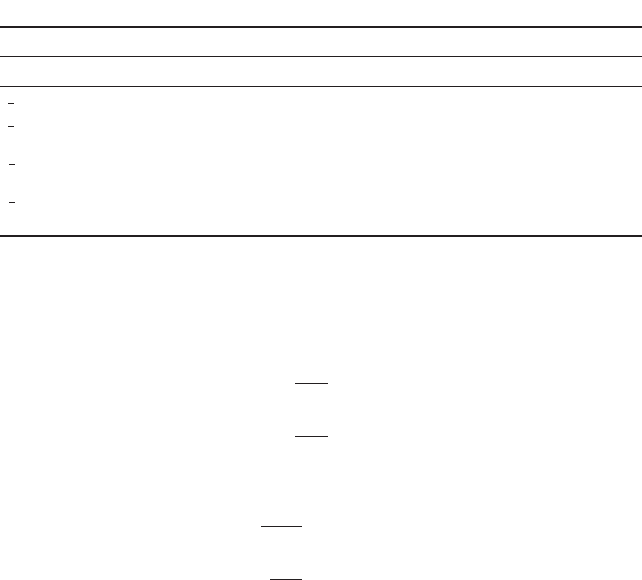
4.2 JET PUMP APPLICATIONS 4.43
TABLE 8 Approximate water consumption of water-jet exhausters, gpm
a, b
Water pressure, lb/in
2
(bar) gage
Size, in (mm) 30 (2.1) 40 (2.8) 60 (4.1) 80 (5.5) 100 (6.9)
(12.7) 2.6 2.9 3.4 3.8 4.2
(19.1) 4.6 5.3 6.4 7.4 8.3
1 (25.4) 6.2 6.8 8.1 9 10
1 (38.1) 20 23 27 30 32
2 (50.8) 28 31 36 41 45
2 (63.5) 46 51 60 67 73
3 (76.2) 66 73 86 96 106
a
gpm 0.227 m
3
/h
b
All flows at 15 in (381 mm) Hg abs.
Source: Schutte and Koerting.
1
2
1
2
3
4
1
2
Table differential:
in USCS units
in SI units
Actual flow:
in USCS units
in SI units
SIPHONS ___________________________________________________________
Operation
As previously defined, the term siphon refers to a jet pump utilizing a con-
densable vapor to entrain a liquid and discharge to a pressure intermediate between
motive and suction pressure. The principal motive fluid is steam.
In an eductor, the high-pressure motive fluid enters through a nozzle and creates a vac-
uum by jet action, which causes suction fluid to enter the mixing chamber. The siphon of Fig-
ure 19 is identical to the eductor of Figure 6 except that, unlike the eductor, the siphon
motive nozzle is a converging-diverging nozzle to achieve maximum velocity at the nozzle
tip. The velocity is supersonic at this point. The motive fluid is condensed into the suction
fluid on contact and imparts its energy to the liquid, thus impelling it through the diffuser.
The diffuser section is the same as an eductor diffuser, and it converts the velocity energy to
pressure at the discharge. To achieve maximum performance, the siphon nozzle must be
expanded to the desired suction pressure in order to achieve the highest possible velocity.
Because negligible radiation losses are encountered, the siphon is 100% thermally efficient
in that the heat in the incoming water plus the heat in the operating steam must equal the
heat of the mixture plus its mechanical energy. Furthermore, the momentum of the incom-
ing water plus the momentum of the expanded steam is equal to the momentum of the dis-
charge mixture less impact and frictional losses.
It is important that the motive steam be condensed in the suction liquid prior to the
throat for proper operation. If condensation does not occur, full available energy is not
transferred. Furthermore, energy must be expended to recompress the uncondensed
19.5 a
4.48
4.64
b
1>2
19.2 m
3
>h
86 a
64.9
67.35
b
1>2
84.4 gpm
5.15 381 a
1.01
762
b 4.64 bar
74.7 15 a
14.7
30
b 67.35 lb>in
2
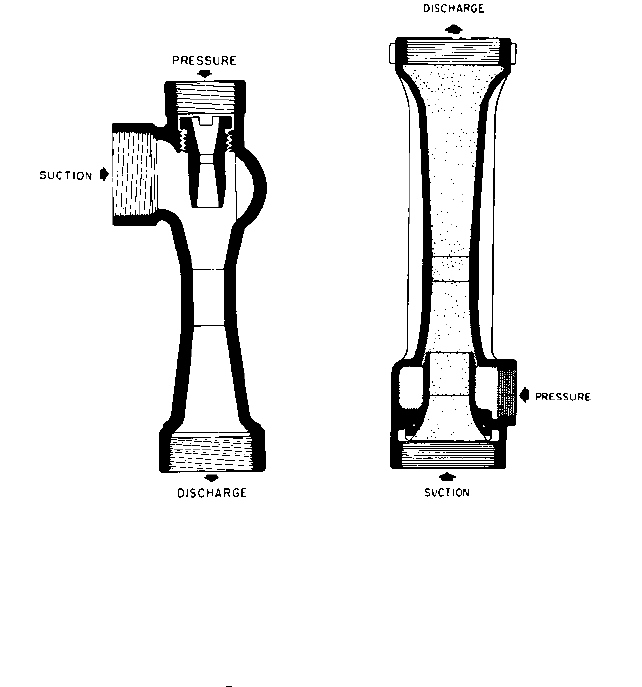
4.44 CHAPTER FOUR
FIGURE 20 Annular siphon (Schutte and Koerting)
FIGURE 19 Standard siphon (Schutte and Koerting)
steam. For this reason, discharge temperature cannot exceed the boiling point at the dis-
charge pressure. The fact that energy is required to recompress any uncondensed steam
explains why air is a very poor motive fluid for liquid pumping.
STANDARD SIPHONS Tables 9 and 10 illustrate the capacity and operating characteristics
of standard siphons.These tables are similar to the eductor capacity tables.To size a unit,
read the suction capacity of a 1 -in (38-mm) unit from Table 9 at the appropriate motive
steam pressure, suction lift, and discharge head. Divide the desired suction flow by this
capacity to find the capacity ratio. From Table 10, find the unit with the next largest
capacity ratio. Read the motive steam required under the proper motive pressure.
Standard materials of construction are cast iron, bronze, stainless, steel, and Pyrex
®
.If
desired, special capacity ratios can be achieved by using a custom-designed unit. Sizes
over 6 in (152 mm) can be fabricated of any suitable material.
ANNULAR SIPHONS Figure 20 illustrates an annular siphon. This unit is identical to the
eductor of Figure 14 except that steam is the motive fluid. Capacity Table 11 is used in
the same manner as previous examples. This type of siphon is used when inline flow is
desired or when the suction liquid contains some solids. Units are available in cast iron
through an 8-in (203-mm) size. Special materials or fabricated designs are also available.
OTHER JET PUMP DEVICES ___________________________________________
Air Siphons
As previously mentioned, air is a very poor motive fluid for entraining a liq-
uid because energy must be expended in compressing the air back to the discharge pressure.
There are, however, applications where it is necessary to sample a liquid with no dilution.
1
2
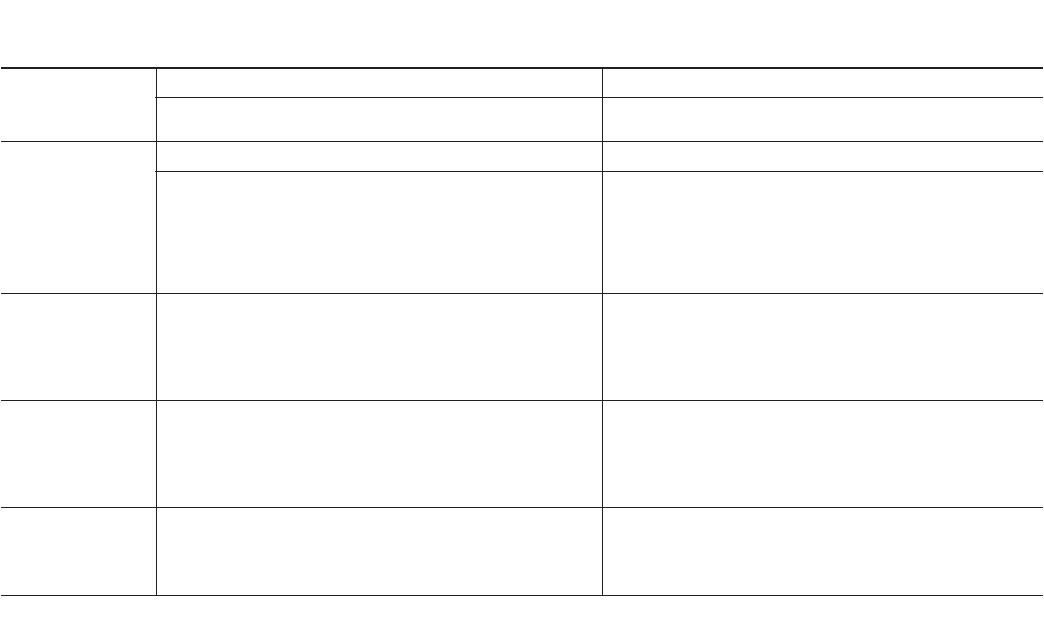
4.45
TABLE 9 Relative capacities of steam-jet siphons, gpm
a
Suction Suction
Operating steam pressure, lb/in
2
(bar) gage Operating steam pressure, lb/in
2
(bar) gage
lift, temp., 40 50 60 80 100 120 160 240 40 50 60 80 100 120 160 240
ft (m) °F
b
(2.8) (3.4) (4.1) (5.5) (6.9) (8.3) (11) (16) (2.8) (3.4) (4.1) (5.5) (6.9) (8.3) (11) (16)
0-ft (m) discharge head 20-ft (6.1-m) discharge head
70 52 51 51 49 46 43 37 30 36 47 48 48 45 41 35 29
90 45 44 43 42 40 37 33 26 37 44 43 43 41 38 33 26
1 (0.3) 110 40 38 36 36 35 33 28 22 38 39 37 37 36 34 30 23
130 35 32 30 30 29 29 25 . . . 35 33 31 31 30 29 25 . . .
150 26 25 24 24 24 24 21 . . . 26 25 24 24 23 22 20 . . .
165 17 17 17 18 18 17 17 . . . 17 17 17 17 17 17 16 . . .
70 38 38 37 35 30 28 25 20 27 36 37 35 31 29 25 19
90 34 34 33 30 27 25 21 17 26 32 32 29 26 23 20 17
10 (3.0) 110 28 27 26 25 23 21 18 . . . 26 27 27 25 23 21 18 . . .
130 21 21 21 20 18 16 14 . . . 21 22 22 21 18 16 14 . . .
145 16 16 16 16 14 12 . . . . . . 16 16 16 16 14 12 . . . . . .
70 34 32 30 26 23 21 18 14 24 33 32 27 24 23 19 15
90 29 28 26 23 20 18 16 12 23 28 27 23 20 19 16 12
15 (4.6) 110 24 23 22 19 17 15 13 . . . 23 23 22 19 17 15 13 . . .
130 17 17 17 15 13 11 . . . . . . 17 17 17 14 13 . . . . . . . . .
145 10 12 11 9 ... ... ... ... 11 11 10 10 ... ... ... ...
70 26 23 21 18 16 15 13 . . . 24 24 22 19 17 15 12 . . .
90 22 19 17 15 14 12 11 . . . 19 20 18 15 14 12 11 . . .
20 (6.1) 110 18 16 14 12 11 10 . . . . . . 17 16 14 12 11 . . . . . . . . .
125 13 12 11 ... ... ... ... ... 12 11 10 ... ... ... ... ...
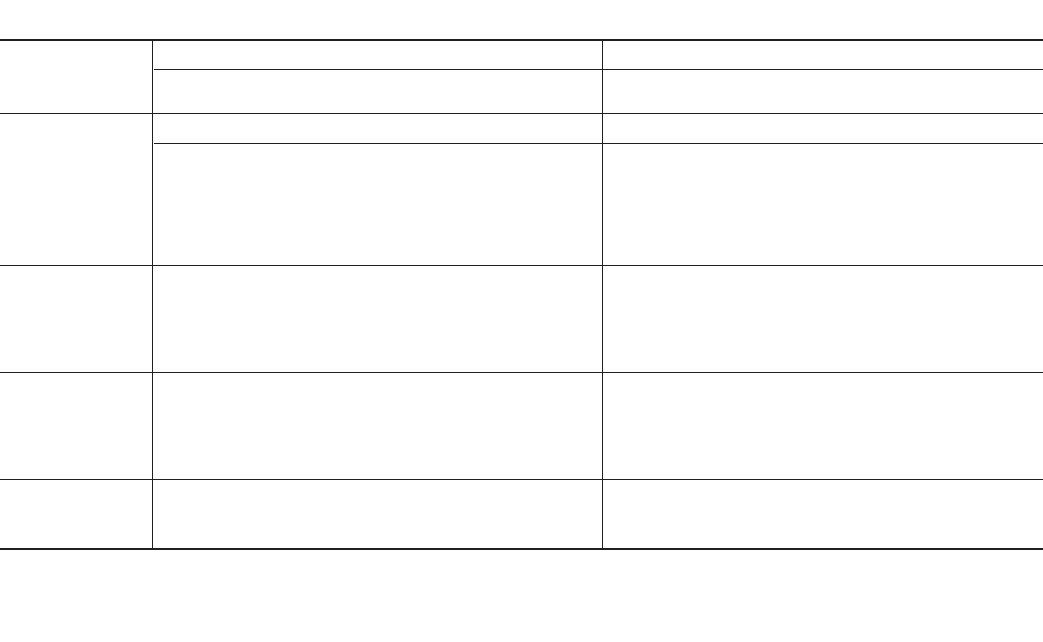
4.46
TABLE 9 Continued.
Suction Suction
Operating steam pressure, lb/in
2
(bar) gage Operating steam pressure, lb/in
2
(bar) gage
lift, temp., 40 50 60 80 100 120 160 240 40 50 60 80 100 120 160 240
ft (m) °F
b
(2.8) (3.4) (4.1) (5.5) (6.9) (8.3) (11) (16) (2.8) (3.4) (4.1) (5.5) (6.9) (8.3) (11) (16)
40-ft (12.2-m) discharge head 50-ft (15.2-m) discharge head
70 . . . 20 33 47 44 41 36 29 . . . . . . 18 44 44 41 36 28
90 . . . 18 36 43 42 39 34 27 . . . . . . 21 42 42 39 34 27
1 (0.3) 110 . . . 20 36 37 37 35 30 24 . . . . . . 24 37 36 34 30 24
130 . . . 23 31 31 30 29 25 . . . . . . . . . 26 30 30 29 25 . . .
150 . . . 24 24 24 24 24 20 . . . . . . . . . 24 24 24 24 20 . . .
165 . . . 17 18 18 18 18 16 . . . . . . . . . 18 18 18 18 16 . . .
70 . . . . . . 24 34 30 27 24 18 . . . . . . . . . 35 30 27 23 18
90 . . . . . . 26 29 26 24 20 17 . . . . . . . . . 29 27 24 21 17
10 (3.0) 110 . . . . . . 27 26 23 20 18 . . . . . . . . . . . . 25 23 20 18 . . .
130 ... ... 22 21 19 16 14 ... ... ... ... 21 19 17 14 ...
145 ... ... 16 16 14 12 ... ... ... ... ... 16 14 13 ... ...
70 . . . . . . 23 28 24 22 19 15 . . . . . . . . . 27 24 21 18 14
90 ... ... 20 24 20 18 16 ... ... ... ... 24 21 18 16 ...
15 (4.6) 110 . . . . . . 21 19 17 15 . . . . . . . . . . . . . . . 19 17 15 . . . . . .
130 ... ... 17 14 12 ... ... ... ... ... ... 14 ... ... ... ...
145 ... ... 11 ... ... ... ... ... ... ... ... ... ... ... ... ...
70 ... ... 21 19 16 15 12 ... ... ... ... ... 16 15 ... ...
20 (6.1) 90 . . . . . . 18 16 14 13 11 . . . . . . . . . . . . . . . 15
C
13
C
... ...
110 ... ... ... 11 10 ... ... ... ... ... ... ... ... ... ... ...
a
gpm 0.227 m
3
/h
b
°C (°F 32)/1.8
c
Suction temperature 85°F (29.4°C)
Source: Schutte and Koerting.
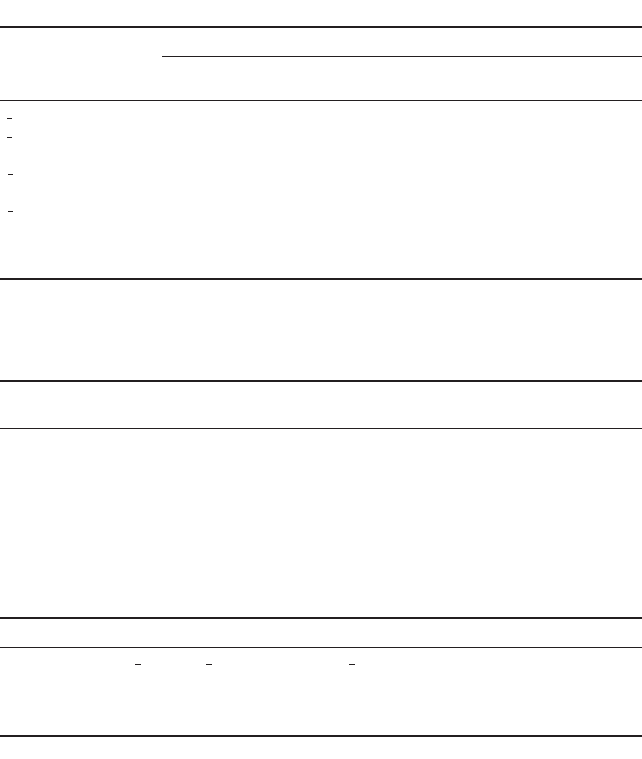
4.2 JET PUMP APPLICATIONS 4.47
TABLE 10 Steam consumption of steam-jet siphons, lb/h
a
Siphon
Operating steam pressure, lb/in
2
(bar) gage
size, in Capacity 40 50 60 80 100 120 160 240
(mm) ratio (2.8) (3.4) (4.1) (5.5) (6.9) (8.3) (11.0) (16.5)
(12.7) 0.125 40 47 54 69 83 97 126 84
(19.1) 0.222 70 83 96 122 147 173 222 322
1 (25.4) 0.346 110 130 150 190 230 270 350 510
1 (38.1) 1.000 318 376 434 550 665 780 1,012 1,475
2 (50.8) 1.38 440 520 600 761 920 1,080 1,400 2,040
2 (63.5) 2.0 635 750 865 1,100 1,329 1,558 2,020 2,940
3 (76.2) 3.11 990 1,170 1,350 1,710 2,065 2,425 3,145 4,590
4 (102) 5.54 1,760 2,085 2,400 3,045 3,685 4,320 5,500 8,170
6 (152) 12.45 3,960 4,680 5,400 6,850 8,280 9,710 12,600 18,360
a
Lb/h 0.454 kg/h
Source: Schutte and Koerting.
1
2
1
2
3
4
1
2
TABLE 11 Relative capacities of annular siphons
Capacity of standard 3-in (76.2-mm) siphon,
water temperature 100°F (37.8°C), 0 suction lift
Steam pressure, lb/in
2
(bar) 50 (3.45) 75 (5.17) 100 (6.90) 125 (8.62)
gage
Steam consumption, lb/h 1180 (535) 1620 (735) 2060 (934) 2490 (1130)
(kg/h)
Max back pressure, lb/in
2
(bar) 12 (0.83) 18 (1.24) 22 (1.52) 35 (2.41)
gage at zero flow
Suction capacity, gpm (m
3
/h) 140 (31.8) 130 (29.5) 120 (27.2) 110 (25)
Discharge pressure, lb/in
2
5 (0.34) 8 (0.55) 12 (0.83) 30 (2.07)
(bar) gage
Relative capacities of standard sizes
Size, in 1 1 2 2 3 4 6 8
(mm) (31.8) (38.1) (50.8) (63.5) (76.2) (102) (152) (203)
Capacity
ratio 0.13 0.21 0.30 0.60 1.00 1.85 4.0 7.1
Source: Schutte and Koerting.
1
2
1
2
1
4
Small units (less than 1 gpm, 0.23 m
3
/h) can be supplied for limited discharge pres-
sures, as indicated by Figure 21.With air as the motive fluid, the suction liquid can be very
close to its boiling point and only a very slight NPSH is required.
When air is used as a motive fluid, the smaller sizes operate more efficiently because
the air is more intimately mixed with a suction fluid. In larger sizes, the tendency is for
the fluid to be discharged in slugs because intimate mixing does not readily occur. This
has a detrimental effect on the performance and especially on available discharge head.
Air-Lift Eductors Air-lift pumps are frequently used for difficult pumping operations.
Compressed air is forced into the bottom of a pipe submerged in the liquid to be pumped.
The expanding air, as it rises up the pipe, entrains the suction fluid.
If compressed air is not available, it is possible to lift water higher than 34 ft (10 m)
with the use of an eductor-air-lift combination. Figure 22 illustrates the suction capacity
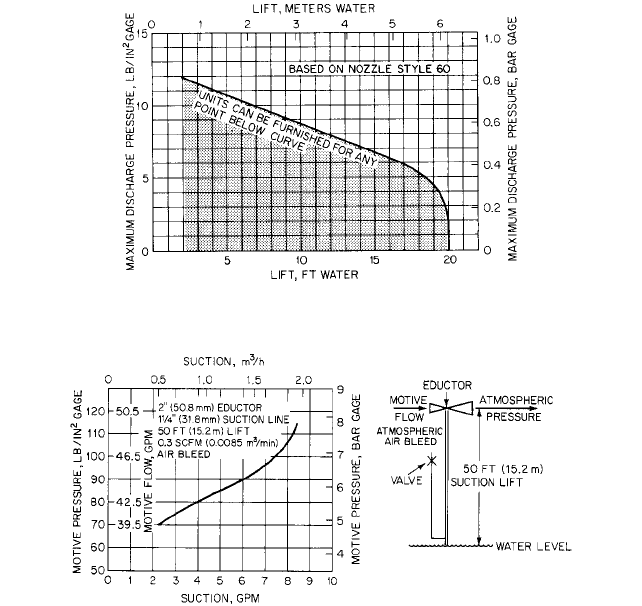
4.48 CHAPTER FOUR
FIGURE 21 Air pumping liquid (Schutte and Koerting)
FIGURE 22 Suction capacity of eductor-air-lift combination (gpm 0.227 = m
3
/h)
of a 2-in (51-mm) eductor drawing water from a 50-ft (15-m) depth and discharging it to
the atmosphere. In operation, an air line from the atmosphere enters the suction pipe near
the water level. As the eductor creates a vacuum in this line, atmospheric pressure forces
air into the suction pipe.After it is in the line, the rising air carries the suction fluid to the
surface and both fluids are discharged to the atmosphere through the eductor.
No sizing data are presented because this type of pump is best specified according to
specific conditions.
Boiler Injectors The boiler injector is a jet pump utilizing steam as a motive fluid to
entrain water, and it is used as a boiler feedwater heater and pump. It differs from a
siphon in that the discharge pressure is higher than either motive or suction pressure.
This is achieved by the double-tube design shown in Figure 23. In operation, the lower
nozzle is activated by pulling the handle partway back. The lower jet creates a vacuum in
the chamber, causing water to be induced into the unit. When water is spilling out the
overflow, the handle is drawn back all the way. This closes the overflow and simultane-
ously admits motive steam to the upper jet. This second jet, which is of the straight or
forcing type, picks up the discharge from the first jet and imparts a velocity to the water
through the discharge tube.The energy contained is sufficient to open the check valve and
discharge against the boiler pressure.
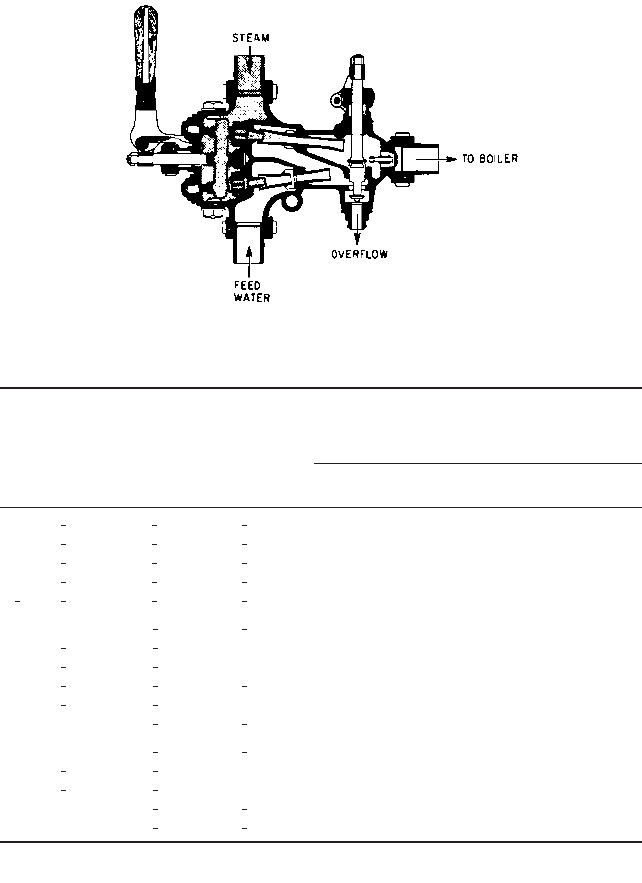
4.2 JET PUMP APPLICATIONS 4.49
FIGURE 23 Boiler injector, starting position (Schutte and Koerting)
TABLE 12 Capacities of boiler injectors, gph
a
Size
overflow
Size iron (drip
pipe Size copper funnel)
Steam pressure, lb/in
2
(bar)
Size conn., pipe OD, pipe, 50 100 150 200 250
no. in (mm) in (mm) in (mm) (3.45) (6.90) (10.34) (13.79) (17.24)
0 (12.7) (9.53) (12.7) 80 100 110 100 90
1 (9.53) (12.7) (12.7) 110 140 180 140 130
2 (12.7) (15.9) (9.33) 170 210 230 200 190
3 (19.1) (22.2) (12.7) 280 340 400 340 320
3 (19.1) (22.2) (12.7) 400 470 550 470 440
4 1 (25.4) 1 (28.6) (19.1) 530 620 720 620 590
5 1 (31.8) 1 (38.1) 1 (25.4) 680 800 920 800 750
6 1 (31.8) 1 (38.1) 1 (25.4) 820 990 1130 990 930
7 1 (38.1) 1 (44.4) 1 (31.8) 1070 1370 1610 1370 1290
8 1 (38.1) 1 (44.4) 1 (31.8) 1400 1800 2100 1800 1700
9 2 (50.8) 2 (57.2) 1 (38.1) 1700 2100 2500 2100 2000
10 2 (50.8) 2 (57.2) 1 (38.1) 2000 2500 2900 2500 2300
11 2 (63.5) 2 (69.8) 2 (50.8) 2500 3000 3500 3000 2800
12 2 (63.5) 2 (69.8) 2 (30.8) 3000 3600 4300 3600 3400
14 3 (76.2) 3 (82.6) 2 (63.5) 3900 4600 5500 4600 4400
16 3 (76.2) 3 (82.6) 2 (63.5) 5000 6000 7000 6000 5700
a
gph 0.00379 m
3
/h
Source: Schutte and Koerting.
1
2
1
4
1
2
1
4
3
4
1
2
3
4
1
2
1
2
1
4
1
2
1
4
3
4
1
2
1
4
3
4
1
2
1
2
1
4
1
2
1
4
3
4
1
8
1
2
7
8
3
4
1
2
1
2
7
8
3
4
3
8
5
8
1
2
1
4
1
2
3
8
1
4
3
8
1
4
The now obsolete steam locomotives were the largest users of this type of injector. Prin-
cipal use at present is as a backup to a regular boiler-feed pump. Capacity Table 12 illus-
trates the range of capacities available for the double-tube injector.

Materials
OF
Construction
C•H•A•P•T•E•R•5
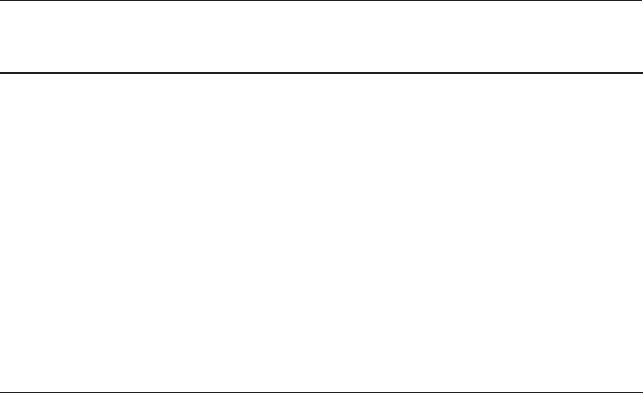
The requirements for a successful pump installation are performance and life. Performance
is the rating of the pump head, capacity, and efficiency. Life is the total number of hours of
operation before one or more pump components must be replaced to maintain an acceptable
performance. The initial performance is the responsibility of the pump manufacturer and
is inherent in the pump design. Life is primarily a measure of the resistance of the mate-
rials of construction to corrosion, erosion, wear, and other factors that can influence the
materials when the pump has been placed in service. The need to maximize reliability and
extend the pump life makes the selection of appropriate materials of construction crucial.
The selection of materials that are both cost-effective and technically suitable for the
application requires a knowledge not only of the pump design and manufacturing pro-
cesses, but also of the engineering properties of the material, particularly its corrosion and
wear resistance properties when subjected to the conditions encountered in the pump. Suf-
ficient information is available in the corrosion and metallurgical literature as well as
from the experience of pump manufacturers to make appropriate material choices for vir-
tually any pumping application.
It is known that several factors lead to a long pump life. These include
• Neutral liquids at near-ambient temperatures
• Appropriate material selections for pumps in aggressive services
• The absence of abrasive particles
• Continuous operation at or near the maximum efficiency capacity of the pump
• An adequate margin of available NPSH over NPSH required as stated on the manu-
facturer’s rating curve
• A low velocity (developed head/rotative speed)
Pumping installations that satisfy all these criteria will have a long life. A typical
example would be a waterworks pump. Some waterworks pumps with bronze impellers
SECTION 5.1
METALLIC MATERIALS
OF PUMP
CONSTRUCTION
(AND THEIR DAMAGE
MECHANISMS)
COLIN O. McCAUL
RONALD S. MILLER
5.3
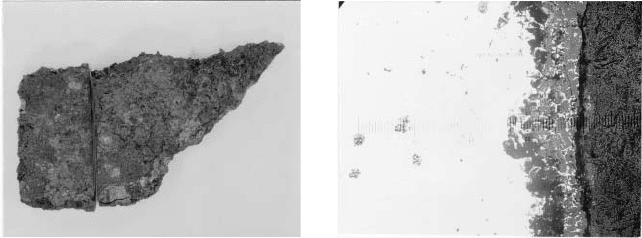
5.4 CHAPTER FIVE
FIGURE 1 A small fragment of Ductile Ni-Resist from the lower casing of a vertical pump. The microstructure is
also shown on the right side of this figure, illustrating the depth of the corrosion’s penetration. This is a classic
example of general corrosion (right photo at 100).
and cast-iron casings have a life of 50 years or more. At the other extreme might be a
chemical pump handling a hot corrosive liquid with abrasive particles carried in suspen-
sion. The life of this pump might be measured in months rather than in years, despite the
fact that construction was based on the most resistant materials available.
Most pumping applications fall somewhere between these two extremes. The pump
designer needs to be familiar with the various types of degradation that can affect the
components of the pump and reduce its useful life. These can be grouped into the general
categories of corrosion, wear, and fatigue, with corrosion and wear being the predominant
life-limiting mechanisms.
TYPES OF CORROSION _______________________________________________
General Corrosion
General corrosion is corrosion that proceeds without an appreciable
localization of attack. This type of corrosion occurs on metals or alloys that do not develop
an effective passive film on the surface. Usually, the corrosion mechanism is oxidation with
the formation of metal oxide corrosion products. General corrosion is most often encountered
in pumps with carbon steels and copper base alloys. Cast irons also experience a specialized
form of general corrosion, known as graphitic corrosion, which will be considered separately.
Carbon steel does not develop a protective oxide film and will corrode at a rate depen-
dent upon several characteristics of the water or other fluid, including temperature, oxy-
gen content, pH, and fluid chemistry. Several empirical indices based on water chemistry
exist and can be used to calculate the relative corrosivity of natural waters to carbon steel
and similar ferrous alloys.The Langelier Index is best known. The rate of corrosion is also
very dependent on velocity and increases with an increasing velocity. In most pump appli-
cations, with the notable exception of hydrocarbons, the corrosion rate of carbon steel is too
high for this material to provide a useful life. However, carbon steel is frequently used, par-
ticularly in vertical pumps, with some form of protective coating to prevent corrosion. Coal
tar epoxy is a preferred coating for many water services.
Copper alloys, including both brasses and bronzes, are also subject to general corrosion
in the water applications where they are most commonly used in the pump industry. The
corrosion rate will be increased by the presence of small amounts of sulfides in the water.
Copper alloys gradually develop a protective copper oxide corrosion film in most applica-
tions. The corrosion rate gradually decreases over time as this film develops. The rate of
general corrosion varies with the specific type or grade of copper alloy. Among the alloys
commonly used in pumps, nickel aluminum bronzes have the lowest corrosion rate and
best tolerance for higher velocities.
The general corrosion of a Ductile Ni-Resist casing from a vertical pump is shown in Fig-
ure 1.A metallographic cross section was removed to show the depth of the corrosion attack.
